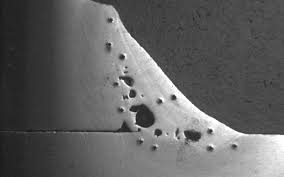Understanding What is Porosity in Welding: Causes and Solutions
Understanding What is Porosity in Welding: Causes and Solutions
Blog Article
Untangling the Secret of Porosity in Welding: Tips for Decreasing Problems and Optimizing Quality
In the elaborate globe of welding, porosity remains a consistent obstacle that can considerably influence the high quality and honesty of bonded joints. Comprehending the variables that add to porosity formation is critical in the pursuit of perfect welds. By unwinding the enigma of porosity and implementing efficient approaches for defect minimization, welders can raise the standards of their work to accomplish premium quality results. As we dive right into the depths of porosity in welding, uncovering the tricks to its avoidance and control will certainly be critical for specialists looking for to understand the art of high-quality weldments.
Understanding Porosity in Welding
Porosity in welding, a common issue encountered by welders, refers to the presence of gas pockets or voids in the bonded product, which can endanger the honesty and top quality of the weld. These gas pockets are commonly caught during the welding process due to numerous factors such as improper shielding gas, contaminated base products, or wrong welding specifications. The formation of porosity can damage the weld, making it prone to breaking and corrosion, ultimately bring about architectural failures.
Understanding the root creates of porosity is vital for welders to successfully avoid its occurrence. By identifying the relevance of maintaining correct gas securing, making sure the cleanliness of base products, and enhancing welding settings, welders can dramatically minimize the possibility of porosity development. Furthermore, utilizing strategies like preheating the base product, utilizing proper welding strategies, and carrying out thorough assessments post-welding can even more assist in reducing porosity flaws. On the whole, an extensive understanding of porosity in welding is essential for welders to generate top quality and sturdy welds.

Common Sources Of Porosity
When evaluating welding processes for prospective quality issues, understanding the common causes of porosity is vital for preserving weld stability and stopping architectural failings. Porosity, defined by the existence of tooth cavities or spaces in the weld metal, can considerably jeopardize the mechanical homes of a welded joint.
One more prevalent source of porosity is the visibility of dampness and impurities externally of the base metal or filler material. When welding products are not effectively cleansed or are subjected to high levels of moisture, the evaporation of these pollutants during welding can create gaps within the weld bead. Additionally, welding at improper criteria, such as excessively high travel rates or currents, can produce excessive disturbance in click to read more the weld swimming pool, trapping gases and creating porosity. By attending to these common reasons with proper gas securing, material preparation, and adherence to optimum welding parameters, welders can minimize porosity and improve the quality of their welds.
Strategies for Porosity Prevention
Applying effective preventative steps is critical in reducing the event of porosity in welding processes. One method for porosity avoidance is guaranteeing correct cleaning of the base metal prior to welding. Impurities such as oil, grease, rust, and paint can bring about porosity, so extensive cleansing using suitable solvents or mechanical approaches is essential.

Utilizing high-grade filler products and securing gases that are ideal for the base metal and welding procedure can dramatically lower the risk of porosity. Additionally, preserving appropriate welding specifications, such as voltage, present, travel speed, and gas circulation price, is essential for porosity avoidance.
In addition, using correct welding methods, such as preserving a constant travel rate, electrode angle, and Our site arc size, can assist stop porosity (What is Porosity). Appropriate training of welders to ensure they follow ideal techniques and top quality control treatments is additionally essential in minimizing porosity issues in welding

Finest Practices for High Quality Welds
One secret technique is preserving proper cleanliness in the welding location. Completely cleaning the work surface and surrounding area prior to welding can help minimize these problems.
An additional ideal method is to thoroughly choose the ideal welding criteria for the specific materials being signed up with. Proper parameter selection ensures optimal weld penetration, fusion, and total quality. Making use of high-quality welding consumables, such as electrodes and filler metals, can significantly impact the last weld top quality.
Relevance of Porosity Control
Porosity control plays a crucial duty in making certain the honesty and high quality of welding joints. Porosity, defined by the presence of cavities or voids within the weld steel, can substantially jeopardize the mechanical residential properties and architectural honesty of the weld. Extreme porosity deteriorates the weld, making it much more susceptible to cracking, deterioration, and general failure under functional tons.
Efficient porosity control is essential for preserving the desired mechanical buildings, such as stamina, ductility, and sturdiness, of the welded joint. What is Porosity. By decreasing porosity, welders can improve the total quality and integrity of the weld, ensuring that it satisfies the efficiency demands of the desired application
Furthermore, porosity control is crucial for achieving the preferred visual look of the weld. Extreme porosity not just weakens the weld however additionally diminishes its visual allure, which can be critical in markets where visual appeals are very important. Correct porosity control techniques, such as utilizing the proper shielding gas, managing the welding specifications, and making certain proper cleanliness of the base materials, are necessary for generating This Site top quality welds with very little flaws.

Conclusion
To conclude, porosity in welding is a typical issue that can compromise the quality of the weld. By comprehending the reasons of porosity and applying correct prevention techniques, welders can reduce problems and accomplish better welds. It is necessary to control porosity in welding to guarantee the stability and stamina of the end product. Executing finest methods for porosity control is vital for attaining optimum welding outcomes.
Report this page